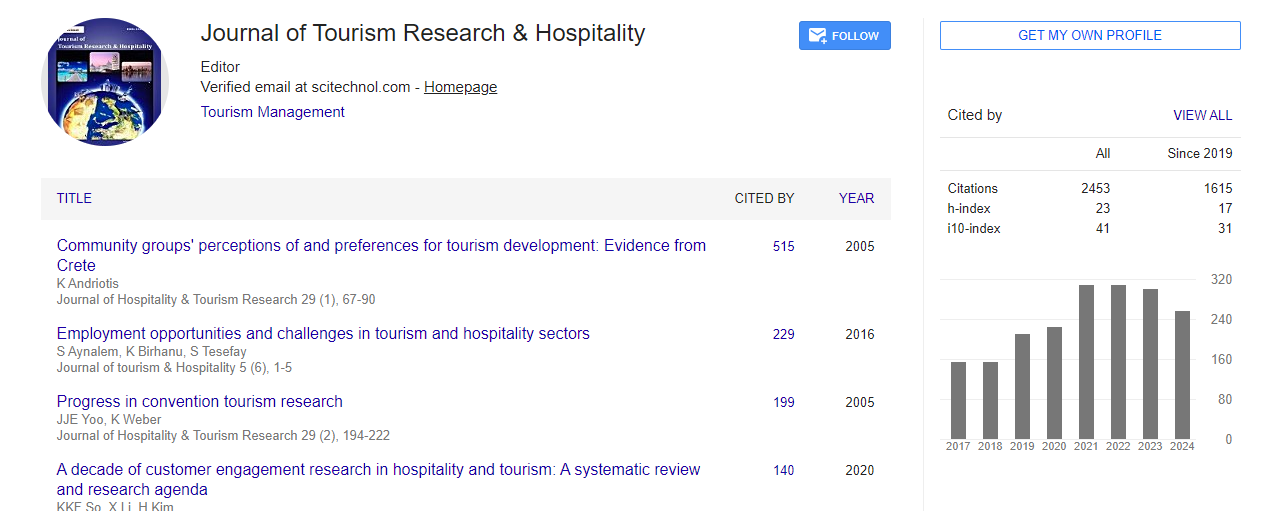Commentary, J Tourism Res Hospitality Vol: 13 Issue: 3
Pricing Strategies: Enhancing Revenue Management in the Hospitality Industry
Ankush Sharma*
1Department of Business Management, Indian Institute of Management, Bangalore, India
*Corresponding Author: Ankush Sharma,
Department of Business Management,
Indian Institute of Management, Bangalore, India
E-mail: anuksh@iim.in
Received date: 24 May, 2024, Manuscript No. JTRH-24-143395;
Editor assigned date: 27 May, 2024, PreQC No. JTRH-24-143395 (PQ);
Reviewed date: 14 June, 2024, QC No. JTRH-24-143395;
Revised date: 21 June, 2024, Manuscript No. JTRH-24-143395 (R);
Published date: 28 June, 2024, DOI: 10.4172/2324-9110.1000187.
Citation: Sharma A (2024) Pricing Strategies: Enhancing Revenue Management in the Hospitality Industry. J Tourism Res Hospitality 13:3.
Description
In the competitive landscape of the hospitality industry, maximizing revenue is essential for maintaining profitability and ensuring longterm success. Revenue management in hospitality involves more than just setting room rates, it encompasses a comprehensive strategy that aligns pricing, inventory management, distribution channels, and guest experience to optimize financial outcomes. This manuscript delves into key strategies and best practices for enhancing hospitality revenue, offering actionable insights for hotels, resorts, and other hospitality establishments. Hospitality revenue management is a systematic approach to selling the right room to the right customer at the right time for the right price. It leverages data analytics, market trends, and consumer behavior insights to make informed decisions that maximize revenue.
Adjusting room rates in real-time based on demand, competition, and market conditions. Managing room availability to optimize occupancy and revenue. Leveraging various distribution channels to reach potential guests. Identifying and targeting different guest segments with tailored pricing and offerings. Utilizing historical data and market trends to predict future demand and set strategic pricing. Dynamic pricing, also known as flexible pricing, is a cornerstone of effective revenue management. It involves adjusting prices based on real-time supply and demand dynamics.
Key components includes
Predicting future demand using historical data, market trends, and booking patterns. Advanced forecasting tools and algorithms can help anticipate fluctuations in demand and adjust pricing accordingly. Monitoring competitors' pricing strategies and market positioning. Understanding competitor rates and promotions helps in setting competitive prices while ensuring profitability. Recognizing that different market segments have varying price sensitivities. For instance, business travelers may book at higher rates compared to leisure travelers. Tailoring pricing strategies to these segments can enhance revenue. Leveraging revenue management software and tools that use algorithms to suggest optimal pricing based on demand forecasts, competitor rates, and historical data.
Distribution strategy
A well-planned distribution strategy ensures that rooms are available through various channels, reaching a broader audience and maximizing booking opportunities. Key components include: Encouraging guests to book directly through the hotel's website. Direct bookings often come with lower distribution costs and higher profitability. Implementing incentives such as discounts or perks for direct bookings can be effective. Partnering with Online Travel Agencies (OTA) to reach a global audience. While OTAs provide valuable exposure, it's essential to manage commission costs and ensure that pricing strategies are aligned with overall revenue goals. Utilizing Global Distribution Systems (GDS) platforms to connect with travel agents and corporate clients. GDS integration can enhance visibility and attract business travelers. Leveraging social media platforms and digital marketing campaigns to attract potential guests. Engaging content, targeted advertising, and promotions can drive traffic to booking channels. Effective guest segmentation allows hotels to tailor their offerings and pricing strategies to different guest groups.
Offering corporate rates, loyalty programs, and business amenities to attract and retain business clients. Understanding corporate travel patterns and preferences helps in designing targeted packages. Creating special offers, family packages, and seasonal promotions to appeal to leisure travelers. Tailoring marketing efforts to specific interests and travel behaviors can drive bookings. Implementing group booking strategies for events, conferences, and weddings. Offering group discounts and customized packages can attract larger bookings and increase overall revenue. Accurate forecasting and data analytics are crucial for making informed revenue management decisions. Key practices include: Reviewing past performance metrics such as occupancy rates, Average Daily Rates (ADR), and Revenue per Available Room (RevPAR). Historical data provides insights into trends and patterns that inform future pricing and inventory strategies. Monitoring market trends, economic indicators, and industry developments. Understanding external factors that impact demand helps in adjusting strategies proactively. Tracking Key Performance Indicators (KPIs) such as ADR, RevPAR, and occupancy rates. Analyzing these metrics provides insights into revenue performance and areas for improvement. Utilizing real-time data from booking engines, revenue management systems, and guest feedback. Real-time data helps in making timely adjustments to pricing and inventory strategies.
 Spanish
Spanish  Chinese
Chinese  Russian
Russian  German
German  French
French  Japanese
Japanese  Portuguese
Portuguese  Hindi
Hindi 

